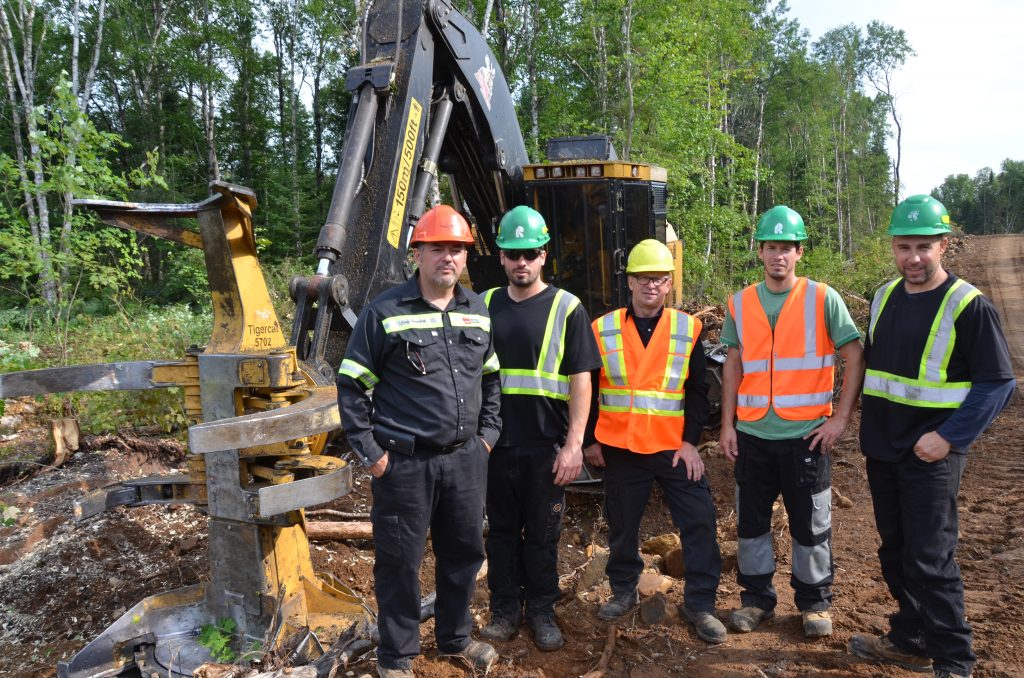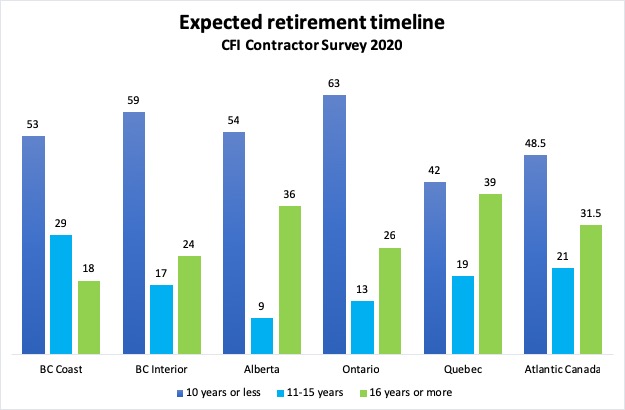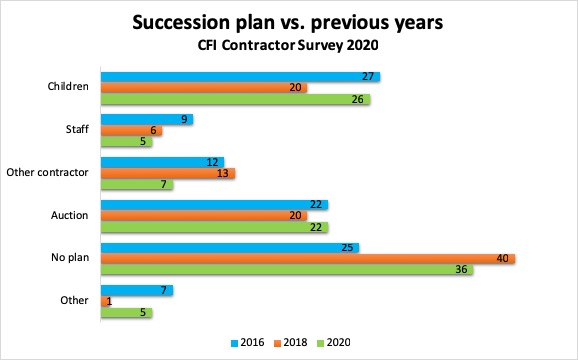
Features
Harvesting
Logging Profiles
Survey snippet 11: What’s the succession plan?
October 21, 2020 By Ellen Cools
 Photo: Annex Business Media
Photo: Annex Business Media Editor’s note: This article was updated on Dec. 10 with updated information regarding contractor age after it was discovered incomplete information had been reported in Survey Snippet 10. CFI apologizes for this error.
For years now, members of the Canadian forest industry have been discussing the challenge of an aging workforce, and who will replace loggers as they retire. As reported in last week’s survey snippet, the average Canadian contractor is now 52 years old, and while there are glimmers of hope that more young people are entering the industry, this doesn’t mean owners don’t need to have a succession plan in place to keep the company around.
Despite the higher average age, results from CFI’s 2020 Contractor Survey show that more loggers expect to spend more than 20 years in the industry than in 2018. Although not at 2016 levels, 17 per cent of contractors expect to stay in the industry for more than 20 years, compared to 14 per cent in 2018.
Most contractors plan to stay in the industry for six to 10 years (24 per cent), compared to 19 per cent in 2018. Fewer contractors, on average, plan to spend less than five years in the industry (27 per cent). There was a corresponding drop in the number of contractors who will stay 16-20 years – 13 per cent compared to 18 per cent in 2018.
However, more loggers in B.C. plan to retire in 10 years or less than in 2018. In the B.C. Interior, the percentage has jumped from 47 per cent in 2018 to 59 per cent in 2020, and in the B.C. Coast, the number has risen from 46 per cent to 53 per cent. This is likely a result of the weak lumber markets in 2019 and challenging fibre supply that saw many B.C. sawmills shut down. With fewer mills, loggers have a harder time getting their products to market.
Alberta has also seen an increase in the percentage of contractors looking to leave the industry in 10 years or less, now at 54 per cent.
But the largest change is in Ontario, where 63 per cent of respondents say they will leave the industry within the next 10 years, compared to just 33 per cent in 2018. This might be explained by the jump in operating costs in the region.
Quebec and Atlantic Canada are the only regions where the majority of contractors plan to be in the industry for longer than 10 years, at 58 per cent and 52.5 per cent, respectively.

Percentage of contractors who report these expected retirement times, by region.
These retirement numbers are somewhat more concerning than the results from our 2018 survey, but, the good news is there are fewer loggers who have no plan for the business to live on. In 2018, 40 per cent of contractors said they had no plan for the company after they retire; in 2020, that number has dropped slightly to 36 per cent.
Similar to 2016, more contractors are willing or able to have their children take over, at 26 per cent, compared to 20 per cent in 2018. However, slightly fewer have managers interested in taking over: five per cent in 2020 compared to six per cent in 2018.
Ultimately, 69 per cent of loggers have no real plan for their business, a drop from 74 per cent in 2018. There has been a slight increase in the number planning to auction their fleet and shut down (22 per cent versus 20 per cent in 2018), but a drop in the number who expect to sell to another contractor (seven per cent versus 13 per cent in 2018).
See how the numbers compare in the chart below.

Percentage of contractors who plan to take these steps when they retire.
Unlike in 2018, when 76 per cent of loggers in Ontario had no succession plan, now 50 per cent expect their kids to take over. This makes sense given the jump in the number of contractors in the province planning to exit the industry within 10 years.
Instead, loggers in Quebec are least likely to have a succession plan (50 per cent), followed by Atlantic Canada (46.5 per cent) and Alberta (46 per cent), which aligns with the larger number of respondents planning to stay in the industry for 16 years or more.
Contractors in B.C., meanwhile, are more evenly split between expecting children to assume control, selling off equipment or no succession plan.
Missed last week’s survey snippet? Find a collection of reports published to date here. Look for more news from the CFI 2020 Contractor Survey in our eNews over the coming weeks, with a final digital report in December and a summary in the November/December print issue. Be sure to subscribe to our free eNews to get all the latest industry news.
This survey was conducted in April and May 2020 by independent research firm Bramm & Associates, generating 271 replies to a detailed list of questions. Respondents were distributed according to the geographic breakdown of the forest industry, with 44 per cent of respondents in Western Canada, 26 per cent in Quebec and the rest found in Ontario, Atlantic Canada, and central Canada. Within B.C., responses were split between the B.C. Coast and Interior. Many thanks to our sponsors for making this research possible – Hultdins, Tigercat and John Deere.
Print this page